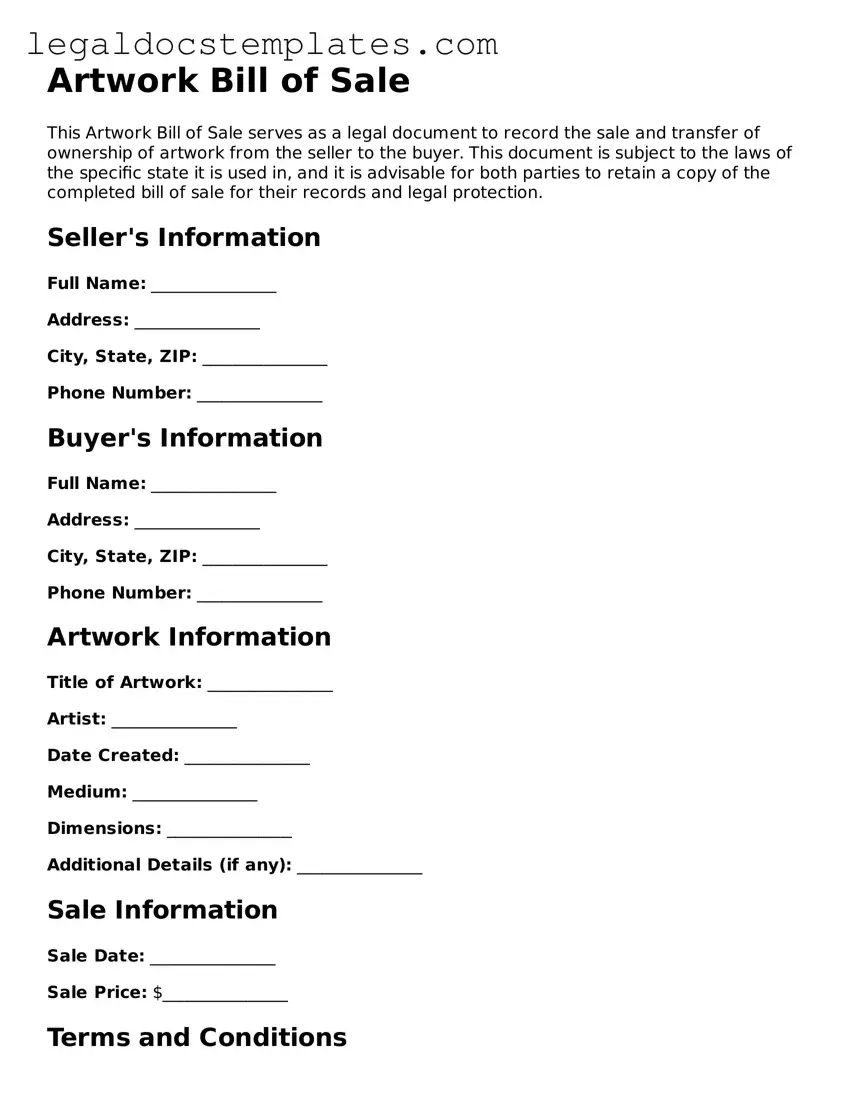The Vehicle Bill of Sale form shares similarities with the Artwork Bill of Sale in its core function, which is to record the transfer of ownership from one party to another. Both documents serve as legal evidence that an item has been sold and purchased, specifying the details of the transaction, including the date, price, and parties involved. The primary difference lies in the nature of the item being transferred—where one deals with vehicles, the other concerns artwork.
Likewise, the Property Bill of Sale is akin to the Artwork Bill of Sale, as both are used to document the sale and transfer of ownership of a valuable asset. They include critical information such as the identities of the buyer and seller, a description of the item sold, the sale date, and the purchase price. The key distinction between them is that the Property Bill of Sale is often used for a broader range of properties, including land and buildings, unlike the more specialized application for artwork.
The Business Bill of Sale is similar to the Artwork Bill of Sale because it formalizes the transfer of ownership of an asset. However, it focuses on business assets, which can range from physical assets like equipment to intangible assets like goodwill or a client list. Both documents ensure there is a record of the sale, providing legal protection and clarity for both the buyer and the seller.
The Equipment Bill of Sale and the Artwork Bill of Sale document the sale of specific items, providing details about the seller, buyer, and the item sold, including a description and sale price. The difference primarily lies in the nature of the items sold; equipment bills cover items like machinery or vehicles used in a business context, while the latter relates specifically to pieces of art.
A General Bill of Sale, much like the Artwork Bill of Sale, is utilized to record the sale of personal property from one person to another. While the General Bill of Sale is broader and can apply to various items such as furniture, electronics, or any other personal property, the Artwork Bill of Sale is expressly for transactions involving art. Both ensure a legal record of the transfer of ownership and protect both parties’ interests.
Likewise, the Boat Bill of Sale is closely related to the Artwork Bill of Sale, as it confirms the sale and purchase of a boat, including relevant details such as the make, model, year, and price—much like the Artwork Bill outlines the specifics of the art piece sold. Though both documents serve similar legal purposes in validating a transaction, the principal difference is the type of property they pertain to.
The Firearm Bill of Sale is similar to the Artwork Bill of Sale in that it is a specialized form used to document the transfer of a specific item, in this case, a firearm. Both forms include details about the transaction and aim to protect both buyer and seller by providing a record of the transfer. However, the Firearm Bill of Sale also often includes specific legal terms and conditions related to the ownership and transfer of firearms, reflecting the regulatory considerations unique to firearms.
The Pet Bill of Sale parallels the Artwork Bill of Sale by providing a legal record of the sale of a living creature, such as a dog or cat, from one owner to another. It includes important details similar to those found in an Artwork Bill, like parties’ information, and a description of the pet, ensuring transparency and accountability. The Artwork Bill of Sale differs in its focus on inanimate objects of value, namely works of art.
Similarly, the Furniture Bill of Sale is akin to the Artwork Bill of Sale as it documents the sale of items of furniture, ensuring there is a clear record of the transaction that includes the description of the items, the sale price, and the parties involved. While one focuses on artworks, the other deals with household items, yet both serve to legally establish the transfer of personal property.
Finally, the Intellectual Property Bill of Sale can be compared to the Artwork Bill of Sale in that it deals with the transfer of ownership of intangible assets. This includes copyrights, patents, or trademarks, which, like artwork, hold significant value. Both documents record essential details of the transaction, offering legal protection and clarity for the rights transferred from the seller to the buyer.
